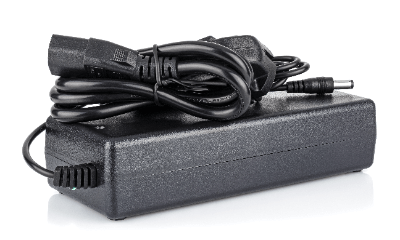What Is a Switching AC Adapter?
 A switching AC adapter is an adapter for converting alternating current (AC) power to direct current (DC) power for information equipment, etc., using the switching method, which is the current mainstream method of AC adapters.
A switching AC adapter is an adapter for converting alternating current (AC) power to direct current (DC) power for information equipment, etc., using the switching method, which is the current mainstream method of AC adapters.
Before the introduction of switching AC adapters, linear AC adapters converted power to low voltage through an iron core (transformer), regulated the AC with diodes, and then used capacitors and other circuits to conduct the electricity to the device being used. On the other hand, unlike the linear method, the switching AC adapter converts AC electricity into high-frequency DC from the start and does not use an iron core (transformer).
The feature of switching AC adapters is that they use switching transistors to perform high-speed voltage conversion, and electricity can flow to the side of the device being used. Since heavy and large transformers are not used, the parts are smaller and lighter, and high power supply efficiency is realized.
Uses of Switching AC Adapters
Switching AC adapters are mainly used in power cables for PCs. Other applications include information communication terminals such as tablets, medical equipment, and audio equipment. Since the power conversion circuit can be separated from the main device, it increases the possibilities of how the device can be used and stored.
And switching AC adapters can be switched on and off without the use of a transformer, making them smaller and lighter. It is also possible to use domestic products overseas, where outlet shapes and power supply/voltage differ by using a converter or transformer.
Since they enable safe, high-precision device operation and are sufficiently resistant to shock and vibration, these days they are being used in a wide range of electronic equipment.
Principle of Switching AC Adapters
Switching AC adapters use a highly efficient switching method, represented by pulse modulation, to convert the desired DC power source in a relatively high-frequency pulse state. This system uses semiconductor devices, such as transistors and MOSFETs, to separate incoming AC voltage into pulses through high-speed switching.
By smoothing the current wave, a flattened DC voltage is obtained. In this process, it is possible to combine power and signals of different frequencies, so it is possible to step down the voltage without a transformer. However, the control method must be carefully considered because of the complexity of the circuitry, and in particular, it is very important to take care of the circuitry of the new switching noise that is generated.
There are several control methods for switching AC adapters, the most typical of which is the “PWN” (pulse width modulation) method. The idea is to stabilize the voltage by adjusting the width of the pulse wave, or the on-time of switching on and off, so that the area of each pulse is the same. Because switching AC adapters can output power without waste by switching power on and off, they are characterized by extremely high power conversion efficiency.
In the case of switching AC adapters, the pulse frequency itself handles higher frequencies than commercial AC frequencies, ranging from several 10 kHz to several 100 kHz. Therefore, they are compact and lightweight, eliminating the need for large, heavy transformers.
How to Choose a Switching AC Adapter
There are many switching AC adapters on the market today. If you make a mistake in selecting the right adapter, you may not only be unable to use your electronic equipment, but in the worst case, you may even damage it.
1. Maximum Rating
The adapter must be capable of delivering the correct voltage (V) and current (A) for the electronic equipment to be used. This is generally found near the input terminals of the electronic equipment or on the rating nameplate. In this case, the voltage should be exactly the same, but the current should be the same or slightly higher.
2. Plug Shape and Polarity
In most cases, the plug part is a pipe-shaped electrode, which provides power by connecting to the contact points of the input terminals of the electronic device, respectively. Since standards have been established to some extent regarding the shape, inner diameter, and polarity of the plug, a compatible plug should be selected for use.
Plugs that convert the outer shape and inner diameter are also available on the market, but the increased number of electrical contacts increases electrical resistance, and this entails the risk of contact failures. It is recommended that plugs with higher voltage and current should not be used.
Other Information on Switching AC Adapters
Switching AC Adapter Using GaN
Compared to the conventional linear method, this switching AC adapter is compact and lightweight because it uses a highly efficient pulse switching method, but it has a certain weight and size for a power conversion adapter for PCs and tablets. Recently, USB-type power adapters using GaN (gallium nitride), a next-generation device, have appeared on the market as even more compact, lightweight, and highly efficient power conversion adapters.
GaN devices have dramatically higher band gap energy and breakdown voltage than conventional Si-based devices, and can operate at higher speeds than SiC (silicon carbide) devices. Therefore, they are suitable for switching operation at higher temperatures and frequencies. The power density per unit area of the transistor can be larger than that of Si-based devices, and the cooling function can be simplified, resulting in smaller, lighter, and more efficient switching AC adapters.
Against this background, manufacturers have recently commercialized more compact portable USB-type switching AC adapters that use GaN devices.